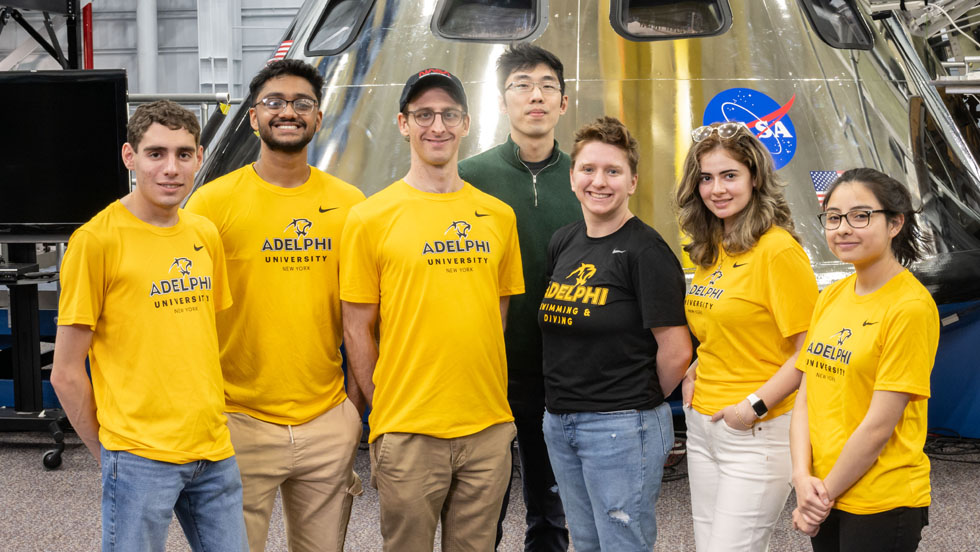
Under the guidance of Kevin Liang, PhD, assistant professor of physics, six computer science majors developed a device and a business plan to “do good while making a profit.”
In February, Kevin Liang, PhD, assistant professor of physics, learned about a NASA competition to develop innovative technologies with global benefits based on the existing inventions, creations and technologies developed by that government agency. He saw that this was a great opportunity for students. Yet there was just one problem: The competition deadline was a month away, which meant Adelphi students would be competing against teams that had been preparing since August.
But challenge accepted. Six computer science majors, guided by Dr. Liang, chose NASA’s solar-powered carbon dioxide conversion technology. They then prepared a technical proposal for the device they would develop: the CO2 Nano Box, which would recycle greenhouse gases from vehicle exhaust emissions.
The team’s proposal described how the device would convert carbon dioxide from truck exhaust into methane and also store the valuable natural gas component until it can be extracted and sold. It also discussed their device’s marketability and potential, as one student put it, for “doing good while making a profit.”
A Significant Opportunity
The competition is NASA’s Minority University Research and Education Project Innovation and Tech Transfer Idea Competition.
Dr. Liang learned about it from Andrea Ward, PhD, College of Arts and Sciences associate provost for research and special projects.
“I thought it was a great opportunity,” Dr. Liang said. “It’s a competition from NASA—which students recognize—that’s limited to minority-serving colleges and universities such as Adelphi.”
The team—Christopher Sciortino, Tyler Reid, Mathew Sabu, Miriam Shamsiev, Sandra Mackay and Delaney Noel—worked from late February until mid-March.
“We wanted to develop a product that would solve a real-world problem and address some of the large climate issues our generation faces, not something that was just easily marketable,” said rising senior Tyler Reid. “So, we set our sights high, which I believe should be the goal of anyone hoping to build something truly innovative.”
Less than two weeks after submitting their proposal, the team learned they’d made it to Phase 2, or Space Tank. “I was pleasantly surprised,” Dr. Liang admitted. “It was a first time for Adelphi, so even submitting was a win.“ He hopes this success will encourage other students to enter the competition in future semesters.
Overcoming Challenges
Reid’s classmate and team point person, Christopher Sciortino, kept them all on target. He acknowledged they faced tough challenges beyond the tight midsemester deadline.
The computer scientists had to get out of their comfort zone and learn unfamiliar physics and chemistry concepts. Dr. Liang provided “valuable insights, guidance and support, which is no doubt a big reason for our success,” Sciortino recalled. “This was a great team-building experience, and now we can all walk away with a stronger sense of togetherness and a great sense of achievement.”
The team and Dr. Liang were in Houston from April 23 to April 26. According to Dr. Liang, they enjoyed a tour of the Johnson Space Center mission control room, which, while closed to the general public, offers tours to those in an invited program such as the competition. They also spoke with an astronaut likely scheduled for a moon flight and received career tips from a flight director—before their culminating pitch presentation.
Future Focused
The Adelphi students were among a field of 60 who also applied for a competitive NASA summer internship. Reid was among the few chosen for an internship with the Ames Research Center in Silicon Valley, known for developing software that models and predicts space missions. “I know it will open doors for me that I never imagined possible,” he said.
Meanwhile, while the team didn’t win the competition, it is still tweaking its device. “Our product is now called the CarbonGuard ACER (Automative Carbon Emissions Reducer),” Sciortino reported. “We want to optimize our product design, grow the team by recruiting others to work with us, and spend more time detailing our plan to grow as a business.
“If anyone thought we were working hard before, they’d better brace themselves. We’re more driven than ever and will succeed. Nothing can stop us now.”